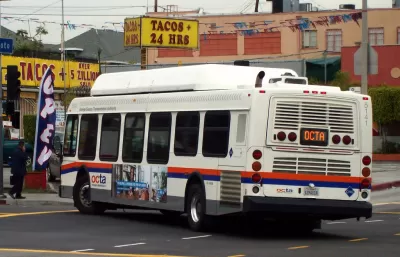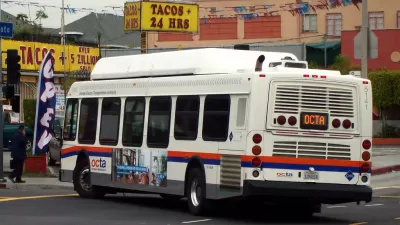Orange County is dealing with falling transit use, and its transit authority is looking for ways to stay afloat.

Like many transit services around the United States, the Orange County Transit Authority (OCTA) is dealing with declining ridership. Its approach to the problem could result in reduced service. "The cuts would come from removing bus trips from 12 routes and eliminating three bus routes to train stations, including bus service to ARTIC, Anaheim’s new transit hub which officials say will improve productivity by trimming resources from routes with fewer riders and eliminating five buses from the agency’s fleet," Thy Vo reports for Voice of the OC.
These cuts would be part of a plan to focus service on the most heavily used routes. "…cuts also reflect the Transportation Authority’s ongoing struggle to cope with falling bus ridership and productivity, which has declined by 19 percent since 2013 despite the fact that the total number of service hours has remained constant," Vo writes.
An article from February 2016 reveals that OCTA has already provoked public outcry by proposing to cut routes.
FULL STORY: As Bus Ridership Keeps Falling, OC Transit Officials Shift Strategies

Planetizen Federal Action Tracker
A weekly monitor of how Trump’s orders and actions are impacting planners and planning in America.

Restaurant Patios Were a Pandemic Win — Why Were They so Hard to Keep?
Social distancing requirements and changes in travel patterns prompted cities to pilot new uses for street and sidewalk space. Then it got complicated.

Map: Where Senate Republicans Want to Sell Your Public Lands
For public land advocates, the Senate Republicans’ proposal to sell millions of acres of public land in the West is “the biggest fight of their careers.”

Maui's Vacation Rental Debate Turns Ugly
Verbal attacks, misinformation campaigns and fistfights plague a high-stakes debate to convert thousands of vacation rentals into long-term housing.

San Francisco Suspends Traffic Calming Amidst Record Deaths
Citing “a challenging fiscal landscape,” the city will cease the program on the heels of 42 traffic deaths, including 24 pedestrians.

California Homeless Arrests, Citations Spike After Ruling
An investigation reveals that anti-homeless actions increased up to 500% after Grants Pass v. Johnson — even in cities claiming no policy change.
Urban Design for Planners 1: Software Tools
This six-course series explores essential urban design concepts using open source software and equips planners with the tools they need to participate fully in the urban design process.
Planning for Universal Design
Learn the tools for implementing Universal Design in planning regulations.
Heyer Gruel & Associates PA
JM Goldson LLC
Custer County Colorado
City of Camden Redevelopment Agency
City of Astoria
Transportation Research & Education Center (TREC) at Portland State University
Camden Redevelopment Agency
City of Claremont
Municipality of Princeton (NJ)





























